Electrical Generation of a Ground-Level Solar Thermoelectric Generator: Experimental Tests and One-Year Cycle Simulation
Abstract
1. Introduction
2. Materials and Methods
2.1. Equipment and Experimental Setup
2.2. Soil Model.
2.3. Model Setup
2.4. Laboratory Test of TEG Performance
3. Results and Discussion
3.1. Experimental Data
3.2. Model Validation
3.3. One-Year Simulation Data
4. Conclusions
Supplementary Materials
Author Contributions
Funding
Acknowledgments
Conflicts of Interest
References
- De Marqui, C. Piezoelectric Energy Harvesting. In Dynamics of Smart Systems and Structures; Lopes Junior, V., Steffen, V., Jr., Savi, M., Eds.; Springer: Basel, Switzerland, 2016; pp. 267–288. [Google Scholar]
- Abdin, Z.; Alim, M.A.; Saidur, R.; Islam, M.R.; Rashmi, W.; Mekhilef, S.; Wadi, A. Solar energy harvesting with the application of nanotechnology. Renew. Sustain. Energy Rev. 2013, 26, 837–852. [Google Scholar] [CrossRef]
- Champier, D. Thermoelectric generators: A review of applications. Energy Convers. Manag. 2017, 140, 167–181. [Google Scholar] [CrossRef]
- Araiz, M.; Casi, Á.; Catalán, L.; Martínez, Á.; Astrain, D. Prospects of waste-heat recovery from a real industry using thermoelectric generators: Economic and power output analysis. Energy Convers. Manag. 2020, 205, 112376. [Google Scholar] [CrossRef]
- Hyland, M.; Hunter, H.; Liu, J.; Veety, E.; Vashaee, D. Wearable thermoelectric generators for human body heat harvesting. Appl. Energy 2016, 182, 518–524. [Google Scholar] [CrossRef]
- Comamala, M.; Cózar, I.R.; Massaguer, A.; Massaguer, E.; Pujol, T. Effects of design parameters on fuel economy and output power in an automotive thermoelectric generator. Energies 2018, 11, 3274. [Google Scholar] [CrossRef]
- Comamala, M.; Pujol, T.; Cózar, I.R.; Massaguer, E.; Massaguer, A. Power and fuel economy of a radial automotive thermoelectric generator: Experimental and numerical studies. Energies 2018, 11, 2720. [Google Scholar] [CrossRef]
- Massaguer, E.; Massaguer, A.; Pujol, T.; Comamala, M.; Montoro, L.; Gonzalez, J.R. Fuel economy analysis under a WLTP cycle on a mid-size vehicle equipped with a thermoelectric energy recovery system. Energy 2019, 179, 306–314. [Google Scholar] [CrossRef]
- Comamala, M.; Massaguer, A.; Massaguer, E.; Pujol, T. Validation of a fuel economy prediction method based on thermoelectric energy recovery for mid-size vehicles. Appl. Therm. Eng. 2019, 153, 768–778. [Google Scholar] [CrossRef]
- García-Contreras, R.; Agudelo, A.; Gómez, A.; Fernández-Yáñez, P.; Armas, O.; Ramos, Á. Thermoelectric energy recovery in a light-duty diesel vehicle under real-world driving conditions at different altitudes with diesel, biodiesel and GTL fuels. Energies 2019, 12, 1105. [Google Scholar] [CrossRef]
- Shittu, S.; Li, G.; Xuan, Q.; Zhao, X.; Ma, X.; Cui, Y. Electrical and mechanical analysis of a segmented solar thermoelectric generator under non-uniform heat flux. Energy 2020, 199, 117433. [Google Scholar] [CrossRef]
- Telkes, M. Solar thermoelectric generators. J. Appl. Phys. 1954, 25, 765–777. [Google Scholar] [CrossRef]
- Kraemer, D.; Poudel, B.; Feng, H.-P.; Caylor, J.C.; Yu, B.; Yan, X.; Ma, Y.; Wang, X.; Wang, D.; Muto, A.; et al. High-performance flat-panel solar thermoelectric generators with high thermal concentration. Nat. Mater. 2011, 10, 532–538. [Google Scholar] [CrossRef] [PubMed]
- Rad, M.K.; Omid, M.; Rajabipour, A.; Tajabadi, F.; Rosendahl, L.A.; Rezaniakolaei, A. Optimum thermal concentration of solar thermoelectric generators (STEG) in realistic meteorological condition. Energies 2018, 11, 2425. [Google Scholar]
- Bellos, E.; Tzivanidis, C. Energy and financial análisis of a solar driven thermoelectric generator. J. Clean. Prod. 2020, 264, 121534. [Google Scholar] [CrossRef]
- Lv, S.; He, W.; Hu, Z.; Liu, M.; Qin, M.; Shen, S.; Gong, W. High-performance terrestrial solar thermoelectric generators without optical concentration for residential and commercial rooftops. Energy Convers. Manag. 2019, 196, 69–76. [Google Scholar] [CrossRef]
- Wei, J.; Zhang, Y.; Wang, J.; Cao, X.; Khan, M.A. Multi-period planning of multi-energy microgrid with multi-type uncertainties using change constrained information gap decision method. Appl. Energy 2020, 260, 114188. [Google Scholar] [CrossRef]
- Chowdhury, N.; Pilo, F.; Pisano, G. Optimal energy storage system positioning and sizing with robust optimization. Energies 2020, 13, 512. [Google Scholar] [CrossRef]
- Li, Q.; Wang, J.; Zhang, Y.; Fan, Y.; Bao, G.; Wang, X. Multi-period generation expansion planning for sustainable power systems to maximize the utilization of renewable energy sources. Sustainability 2020, 12, 1083. [Google Scholar] [CrossRef]
- Luo, X.; Guo, Q.; Tao, Z.; Liang, Y.; Liu, Z. Modified phase change materials used for thermal management of a novel solar thermoelectric generator. Energy Convers. Manag. 2020, 208, 112459. [Google Scholar] [CrossRef]
- Shittu, S.; Li, Q.; Xuan, Q.; Xiao, X.; Zhao, X.; Ma, X.; Akhlaghi, Y.G. Transient and non-uniform heat flux effect on solar thermoelectric generator with phase change material. Appl. Therm. Eng. 2020, 172, 115206. [Google Scholar] [CrossRef]
- Charris, D.; Gomez, D.; Rincon Ortega, A.; Carmona, M.; Pardo, M. A thermoelectric energy harvesting scheme with passive cooling for outdoor IoT sensors. Energies 2020, 13, 2782. [Google Scholar] [CrossRef]
- Zhang, Z.; Wu, Y.; Li, W.; Xu, D. Performance of a solar thermoelectric power-harvesting device based on an all-glass solar heat transfer pipe and gravity-assisted heat pipe with recycling air cooling and water cooling circuits. Energies 2020, 13, 947. [Google Scholar] [CrossRef]
- Wang, H.; Li, W.; Xu, D.; Kan, J. A hybrid microenergy storage system for power supply of forest wireless sensor nodes. Electronics 2019, 8, 1409. [Google Scholar] [CrossRef]
- Carvalhaes-Dias, P.; Cabot, A.; Siqueira Dias, J.A. Evaluation of the thermoelectric energy harvesting potential at different latitudes using solar flat panels systems with buried heat sink. Appl. Sci. 2018, 8, 2641. [Google Scholar] [CrossRef]
- Lawrence, E.E.; Snyder, G.J. A Study of Heat Sink Performance in Air and Soil for Use in A Thermoelectric Energy Harvesting Device. In Proceedings of the Twenty-First International Conference on Thermoelectrics, Long Beach, CA, USA, 29 August 2020; pp. 446–449. [Google Scholar]
- Stevens, J.W. Performance factors for ground-air thermoelectric power generators. Energy Convers. Manag. 2013, 68, 114–123. [Google Scholar] [CrossRef]
- Whalen, S.A.; Dykhuizen, R.C. Thermoelectric energy harvesting from diurnal heat flow in the upper soil layer. Energy Convers. Manag. 2012, 64, 397–402. [Google Scholar] [CrossRef]
- Huang, Y.; Xu, D.; Kan, J.; Li, W. Study on field experiments of forest soil thermoelectric power generation devices. PLoS ONE 2019, 14, 1–13. [Google Scholar] [CrossRef] [PubMed]
- Jiang, W.; Yuan, D.; Xu, S.; Hu, H.; Xiao, J.; Sha, A.; Huang, Y. Energy harvesting from asphalt pavement using thermoelectric technology. Appl. Energy 2017, 205, 941–950. [Google Scholar] [CrossRef]
- Morais, F.; Carvalhaes-Dias, P.; Daurte, L.; Spengler, A.; de Paiva, K.; Martins, T.; Cabot, A.; Siqueira Dias, J. Optimization of the TEGs configuration (series/parallel) in energy harvesting systems with low-voltage thermoelectric generators connected to ultra-low voltage DC-DC converters. Energies 2020, 13, 2297. [Google Scholar] [CrossRef]
- Shen, B.; Hendry, R.; Cancheevaram, J.; Watkins, C.; Martini, M.; Venkatasubramanian, R. DC-DC Converter Suitable for Thermoelectric Generator. In Proceedings of the 24th International Conference on Thermoelectrics, Clemson, SC, USA, 24 October 2005; pp. 529–531. [Google Scholar]
- Desai, N.V.; Ramadass, Y.K.; Chandrakasan, A.P. A bipolar ±40 mV self-starting boost converter with transformer reuse for thermoelectric energy harvesting. In Proceedings of the 2014 international symposium on low power electronics and design, La Jolla, CA, USA, 11–13 August 2014; pp. 221–226. [Google Scholar]
- Kimura, K.; Koizumi, H. A bipolar power converter with bridgeless boost rectifier for thermoelectric Energy Harvesting. In Proceedings of the 2015 IEEE 2nd International future energy electronics conference (IFEEC), Taipei, Taiwan, 1–4 November 2015; pp. 1–6. [Google Scholar]
- Paraskevas, A.; Koutroulis, E. A simple maximum power point tracker for thermoelectric generators. Energy Convers. Manag. 2016, 108, 355–365. [Google Scholar] [CrossRef]
- Weather Station NuclierData—Data download. Available online: http://nuclierdata.udg.edu/ (accessed on 4 May 2020).
- Wu, J.; Nofziger, D.L. Incorporating temperatura effects on pesticide degradation into a management model. J. Environ. Qual. 1999, 28, 92–100. [Google Scholar]
- Institut Cartogràfic i Geològic de Catalunya. Available online: https://www.icgc.cat/ (accessed on 8 April 2019).
- Llopis, G.; Rodrigo, V. Guía de la Energía Geotérmica; Dirección General de Industria, Energía y Minas, Consejería de Economía y Consumo, Comunidad de Madrid: Madrid, Spain, 2008. [Google Scholar]
- Bergman, T.L.; Lavine, A.S.; Incropera, F.P.; DeWitt, D.P. Fundamentals of Heat and Mass Transfer, 7th ed.; John Willey & Sons: Hoboken, NJ, USA, 2011. [Google Scholar]
- Photovoltaic Geographical Information System (PVGIS). Available online: https://ec.europa.eu/jrc/en/pvgis (accessed on 7 May 2020).
- Cózar, I.R.; Pujol, T.; Lehocky, M. Numerical analysis of the effects of electrical and thermal configurations of thermoelectric modules in large-scale thermoelectric generators. Appl. Energy 2018, 229, 264–280. [Google Scholar] [CrossRef]
- Calderón-Henao, N.; Venturini, O.J.; Medina Franco, E.H.; Silva Lora, E.E.; Scherer, H.F.; Yepes Maya, D.M.; Ando Junior, O.H. Numerical-experimental performance assessment of a non-concentrating solar thermoelectric generator (STEG) operating in the southern hemisphere. Energies 2020, 13, 2666. [Google Scholar] [CrossRef]
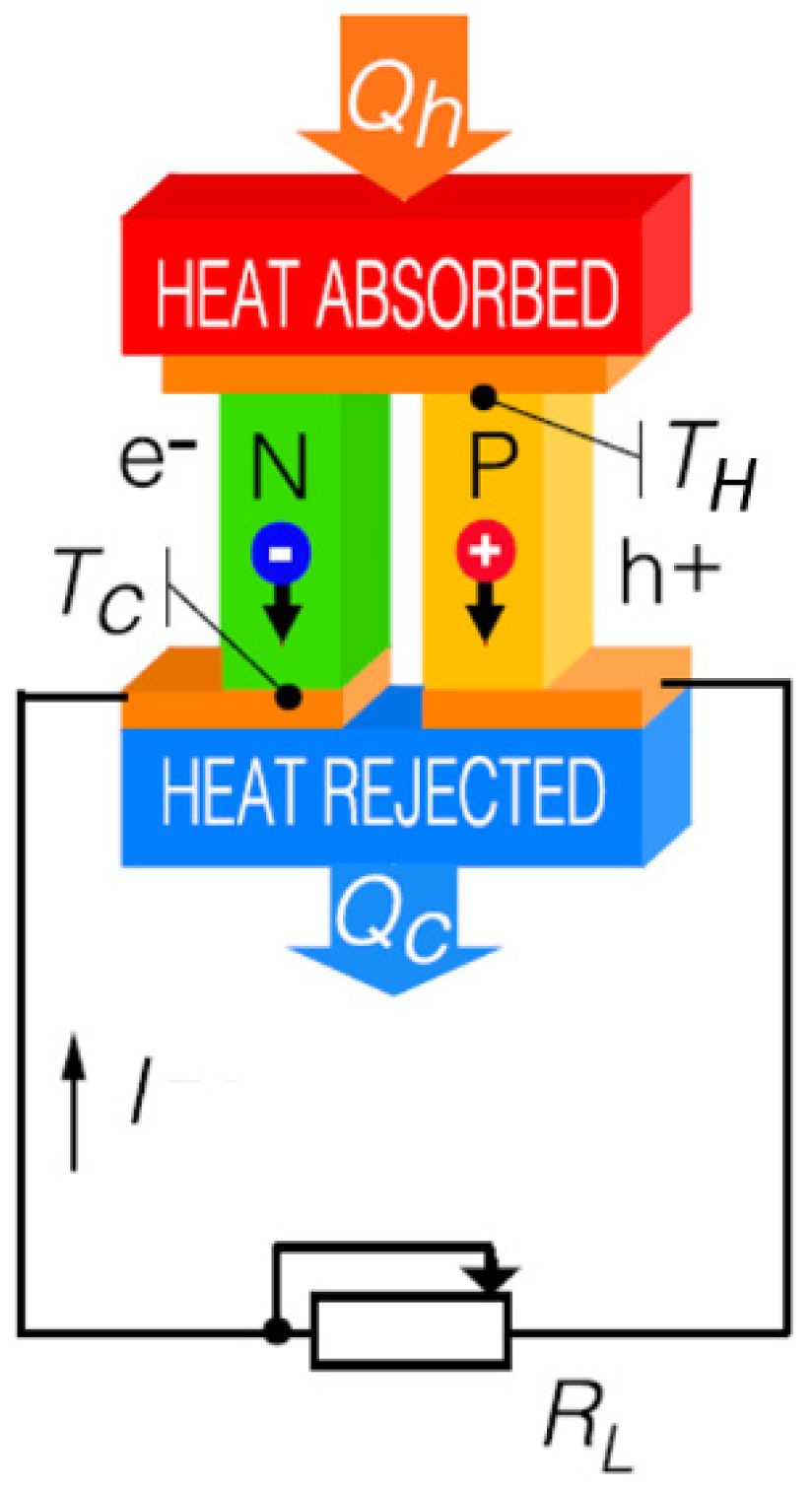
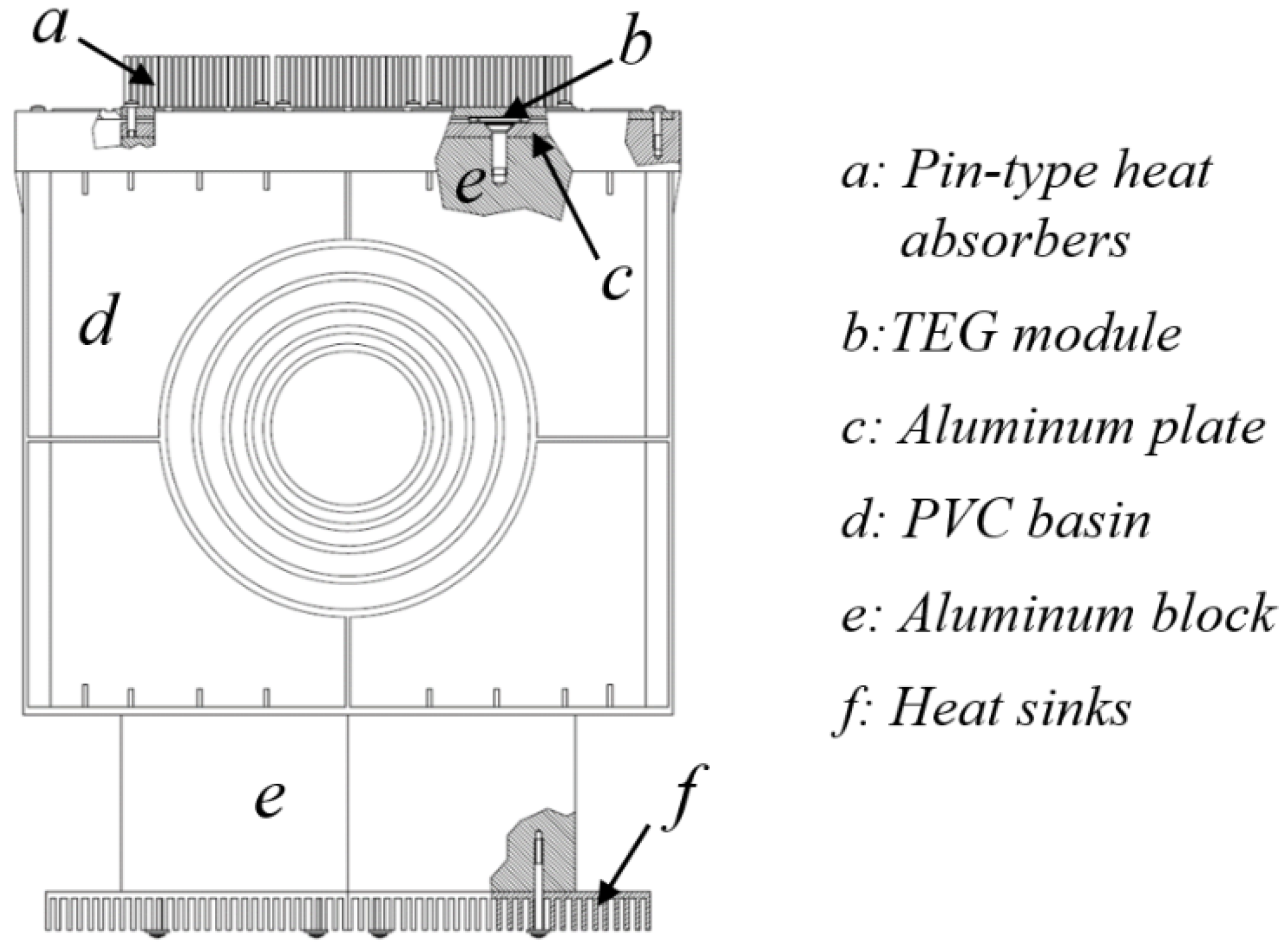


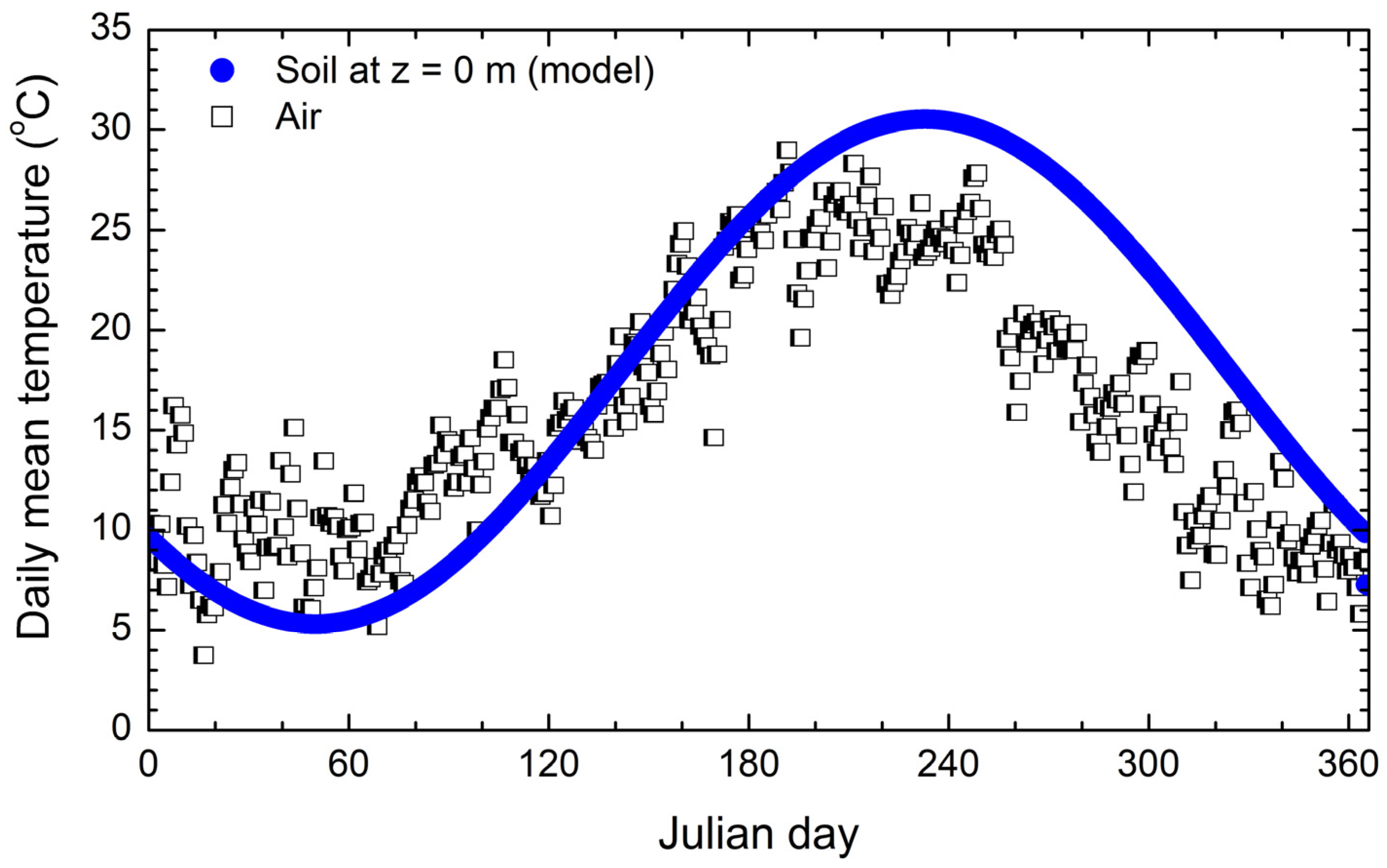
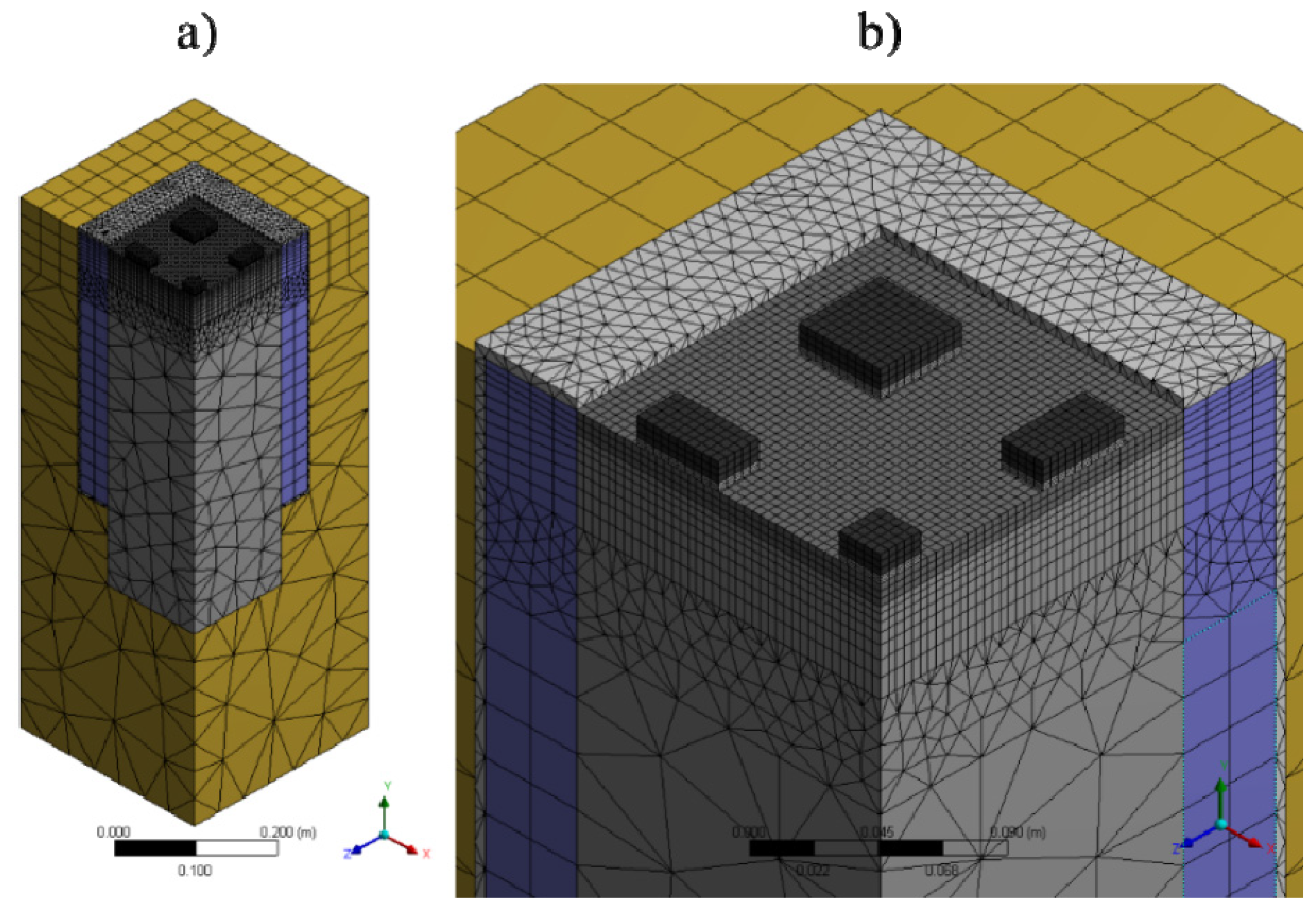
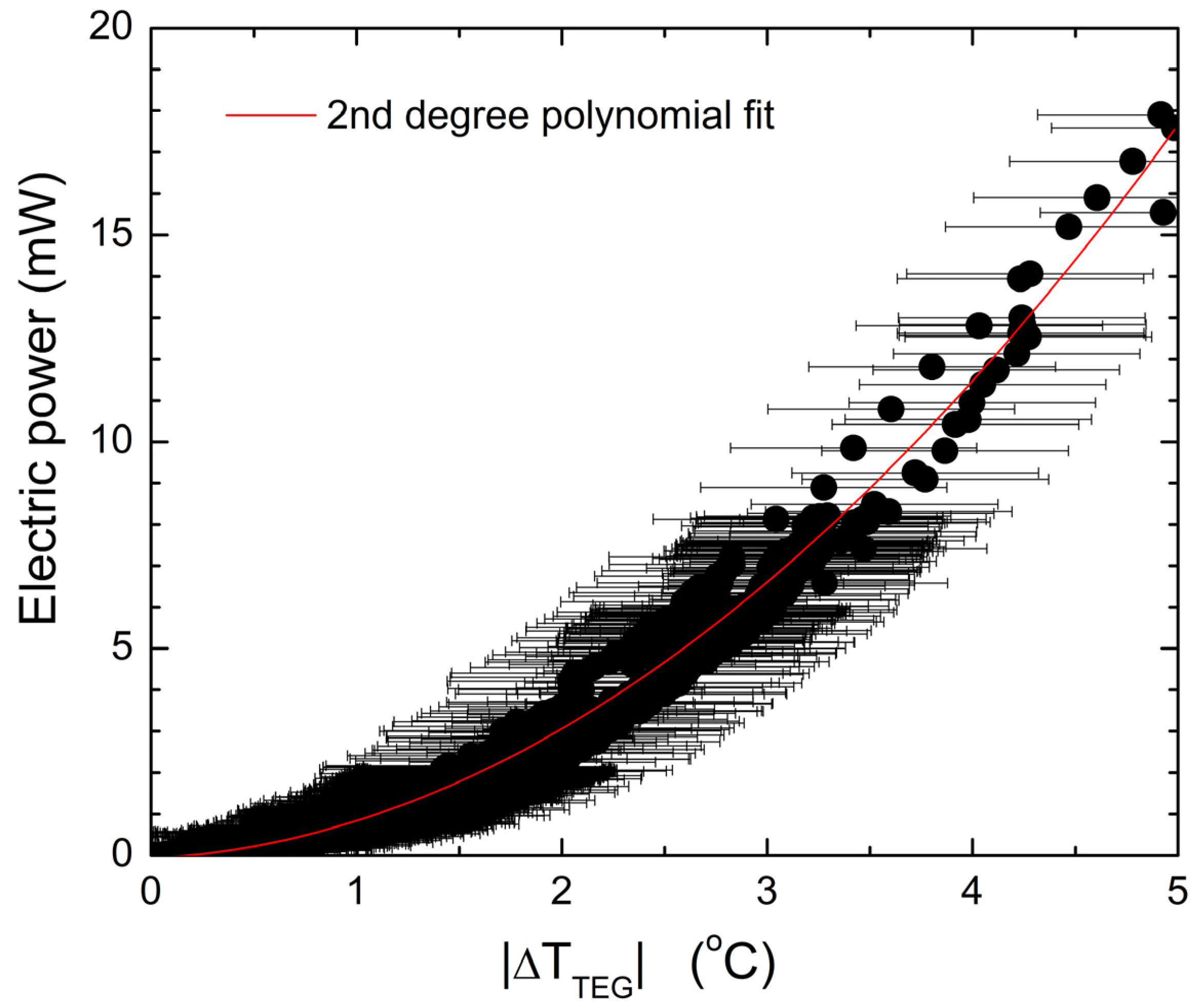
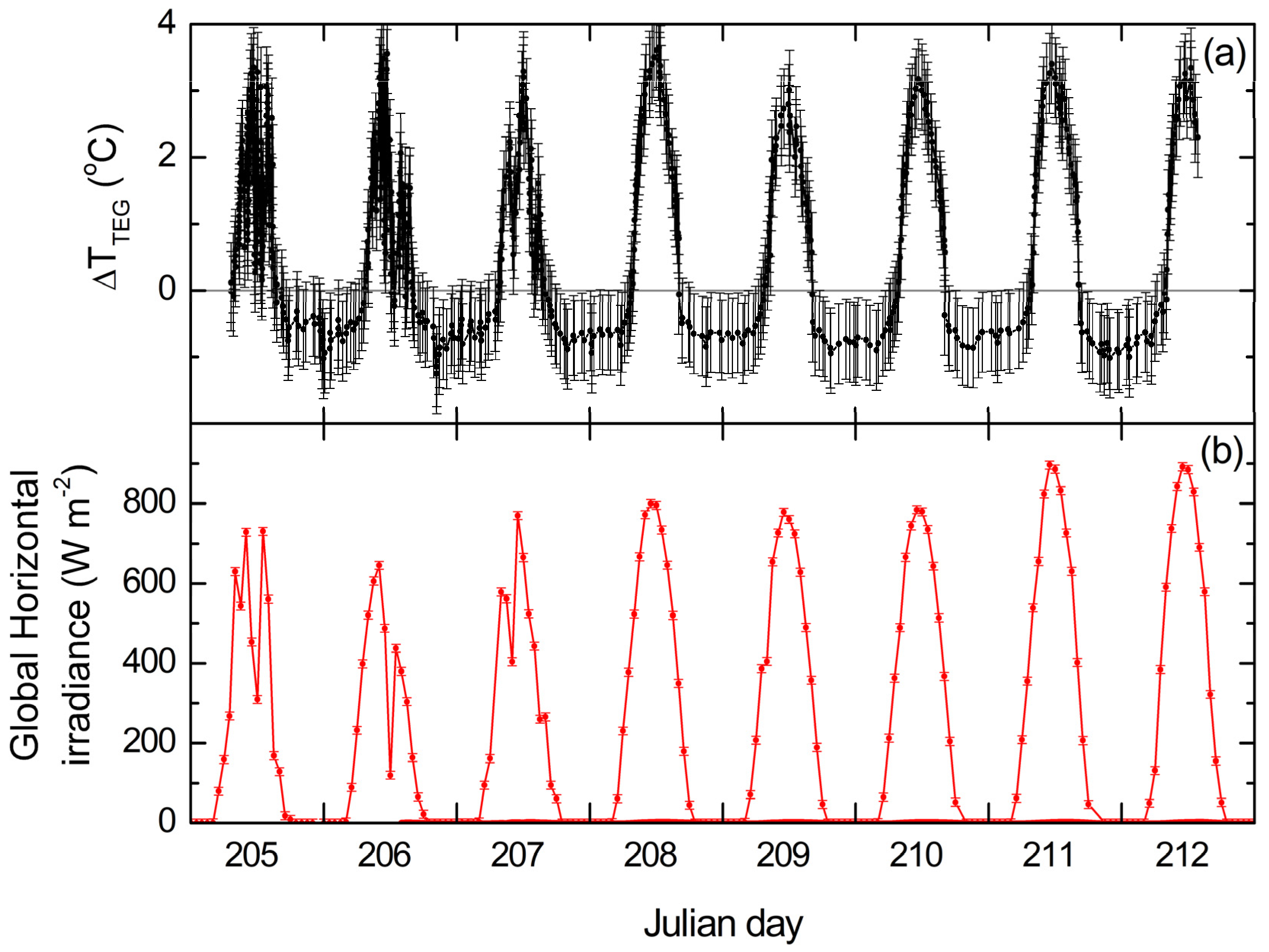

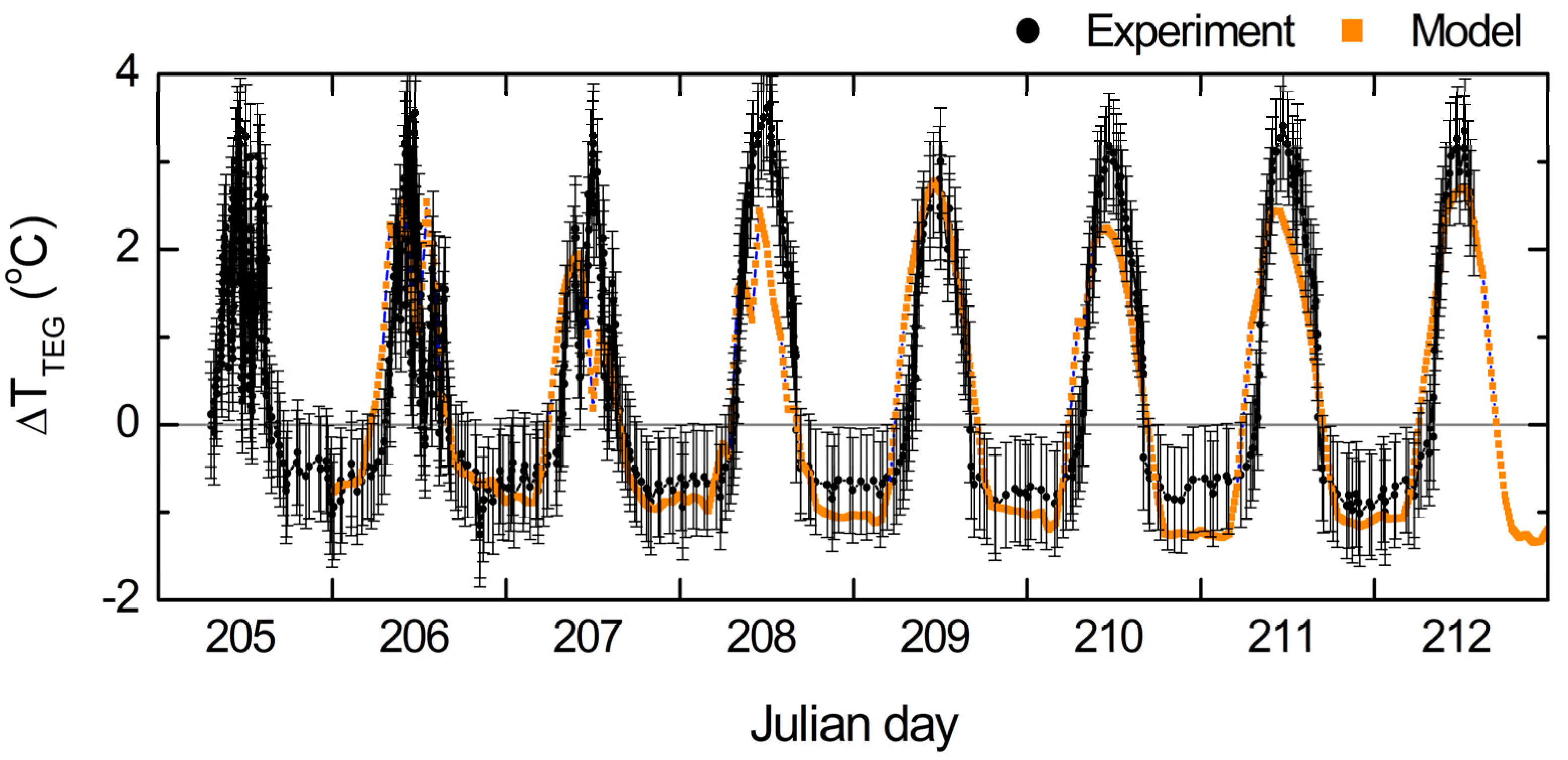
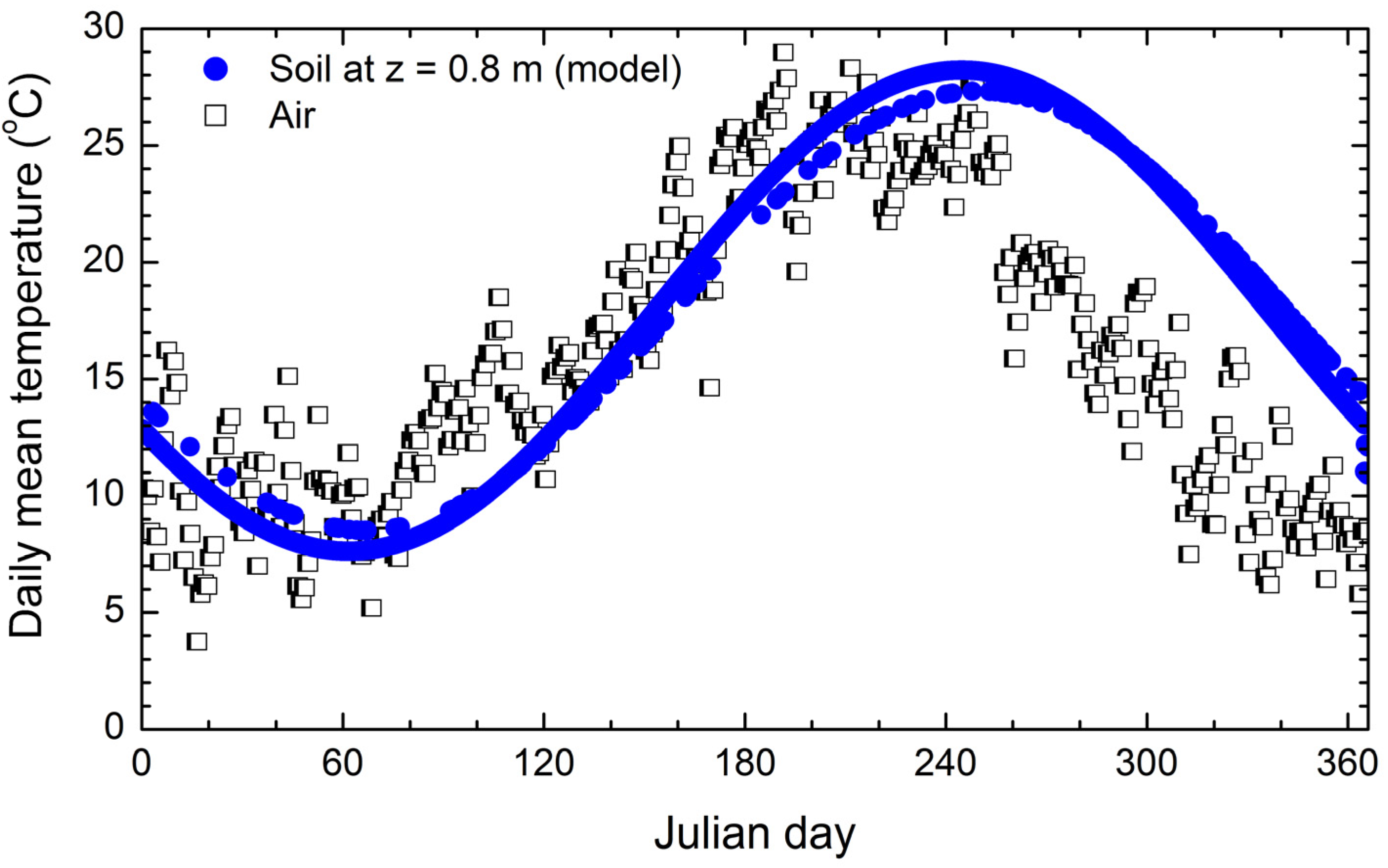
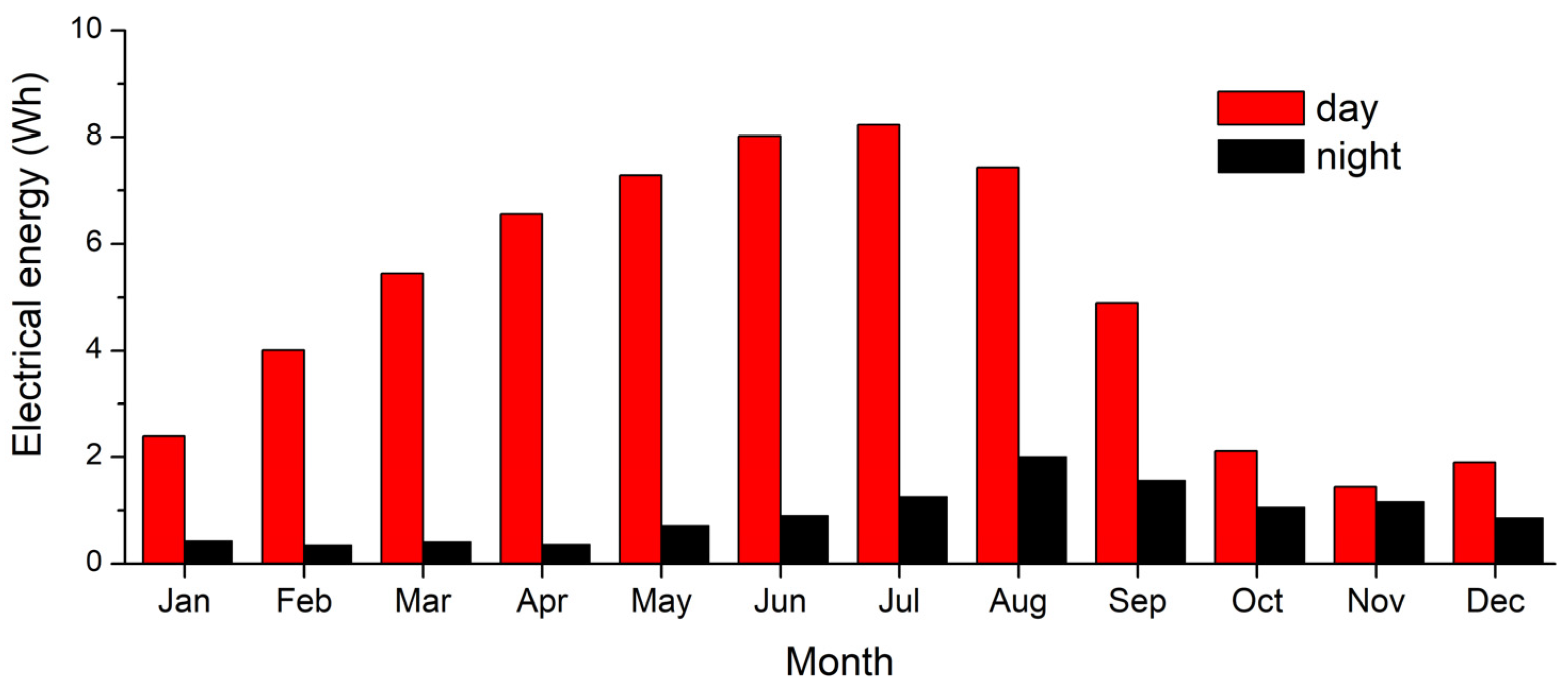
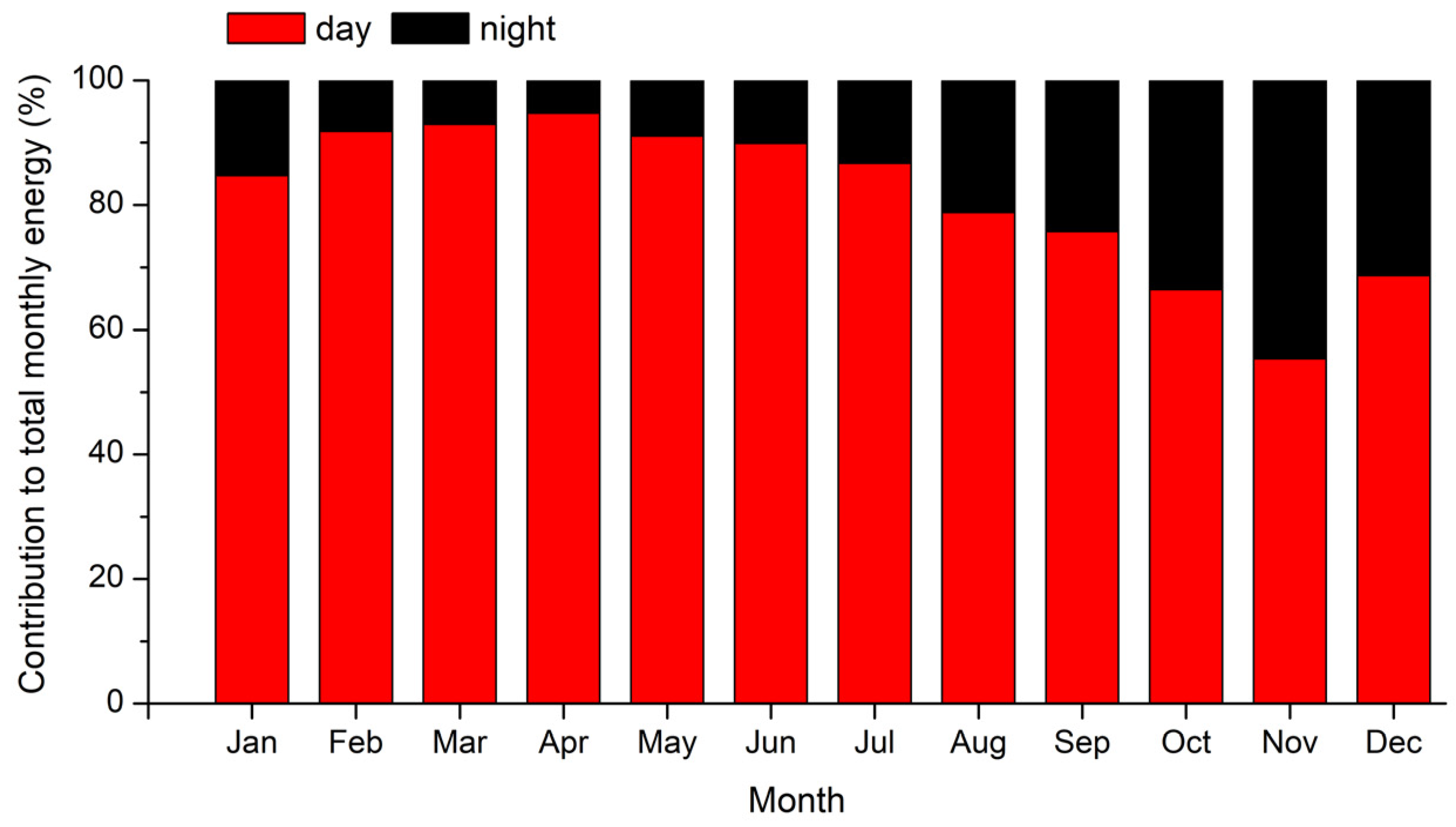

| Soil Heat Exchanger | Air Heat Exchanger | #TEGs | Depth (m) | Peak Power (mW) | Energy Per Day (J d−1) | Energy Density Per Day (J m−3d−1) | Ref | |
|---|---|---|---|---|---|---|---|---|
| Gravity heat pipe | - | 8 | 2.50 | 24 | 0.43 | 25.90 | 10,300 | [24] |
| Al finned | Black flat plate | 1 | 0.10 | 22 | - | 24.40 | - | [25] |
| Starfish Cu | Al finned 1 | 1 | 0.30 | 10 | 0.39 | 3.40 | - | [26] |
| Finned | Finned | 2 | 1.30 | 25 | 1.05 | 73.80 | 201,000 | [27] |
| Black flat plate | Black flat plate | 4 | 0.01 | - | 6.00 | 95.10 | 1.36 × 106 | [28] |
| Starfish Cu | Cu finned | 8 | 3.30 | 4.6 | 3.70 | 128.00 | 51,198 | [29] |
| Vapor chamber | Water tank + vapor chamber | 3 | 0.02 | 17 | 45.00 | 840.00 | 93,333 | [30] |
| Al block | Al finned | 9 | 0.40 | 3.5 | 79.79 | 696.96 | 8737 |
© 2020 by the authors. Licensee MDPI, Basel, Switzerland. This article is an open access article distributed under the terms and conditions of the Creative Commons Attribution (CC BY) license (http://creativecommons.org/licenses/by/4.0/).
Share and Cite
Massaguer, E.; Massaguer, A.; Balló, E.; Cózar, I.R.; Pujol, T.; Montoro, L.; Comamala, M. Electrical Generation of a Ground-Level Solar Thermoelectric Generator: Experimental Tests and One-Year Cycle Simulation. Energies 2020, 13, 3407. https://doi.org/10.3390/en13133407
Massaguer E, Massaguer A, Balló E, Cózar IR, Pujol T, Montoro L, Comamala M. Electrical Generation of a Ground-Level Solar Thermoelectric Generator: Experimental Tests and One-Year Cycle Simulation. Energies. 2020; 13(13):3407. https://doi.org/10.3390/en13133407
Chicago/Turabian StyleMassaguer, Eduard, Albert Massaguer, Eudald Balló, Ivan Ruiz Cózar, Toni Pujol, Lino Montoro, and Martí Comamala. 2020. "Electrical Generation of a Ground-Level Solar Thermoelectric Generator: Experimental Tests and One-Year Cycle Simulation" Energies 13, no. 13: 3407. https://doi.org/10.3390/en13133407
APA StyleMassaguer, E., Massaguer, A., Balló, E., Cózar, I. R., Pujol, T., Montoro, L., & Comamala, M. (2020). Electrical Generation of a Ground-Level Solar Thermoelectric Generator: Experimental Tests and One-Year Cycle Simulation. Energies, 13(13), 3407. https://doi.org/10.3390/en13133407





